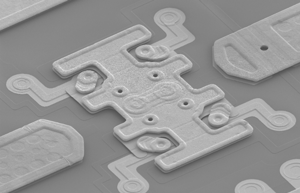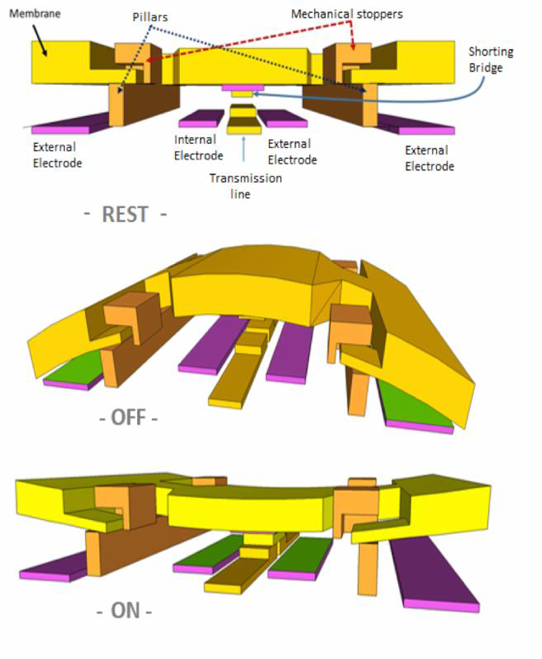- News
1 June 2015
DelfMEMS' SP12T RF-MEMS ohmic switch passes 1 billion operations milestone
DelfMEMS of Villeneuve d'Ascq, France, which develops RF MEMS (micro-electro-mechanical systems) switches for radio-frequency communications (targeting next-generation multi-standard, multi-mode mobile telephony), says that its 12-throw RF-MEMS ohmic contact switch design has just passed the 1 billion test cycles milestone and is still going strong.
"This is the first time an industrialized RF-MEMS contact switch has been shown to achieve this level of performance, but this is only the beginning," says CEO Cybele Rolland. "Our second-generation production switches, which we will be shipping towards the end of 2016, are expected to achieve up to 50 billion operations," she adds. "This ensures that they will reliably deliver the performances required for the next generation of handsets, LTE-A and beyond, with ultra-low insertion loss, outstanding isolation and superior linearity, which for end-users translates to longer battery life, better call quality and massively increased data speeds."
DelfMEMS cites two key innovations helping it to achieve the milestone. First, although gold is currently used as the contact material, this will be replaced in the production switches by a metal compound that has been proven to be reliable for cold switching in excess of 50 billion cycles. Second, the firm's patented FreeFlex MEMS switch design ensures that the contact point is always changing slightly, lengthening the life of the switch.
 Picture: DelfMEMS' FreeFlex RF-MEMS switch.
Picture: DelfMEMS' FreeFlex RF-MEMS switch.
DelfMEMS says that its RF-MEMS switch structure uses a new, integrated, micro-mechanical building block that is based on a robust IP portfolio that includes seven key patents and innovations. It does not use a cantilever beam or bridge featuring a highly conductive electrode electrostatically actuated in order to create an ohmic contact resulting in a mechanical switching. These older structures have proved to have several issues, says the firm: stress on the anchors, possible stiction, low commutation speed and possible creep of the beam.

Picture: DelfMEMS' FreeFlex switch design.
DelfMEMS' design approach has resulted in the development of an anchorless structure for mechanical RF switching that, it is claimed, totally overcomes these historical design problems instead of trying to simply reduce them.
The FreeFlex membrane is always in a known controlled state as it is electrostatically actuated by two sets of electrodes. The electrostatically ON state is achieved by making physical contact between the membrane contact area and the transmission line, and the similarly controlled OFF state is achieved by keeping a physical distance between the membrane contact area and the transmission line. This means that the switch contact area will either be attracted to the conductive line or repelled from it. Moving from ON state to OFF state is made through an electrostatic active actuation, which de-couples between restoring forces, contact forces and the membrane mechanical properties.
Another feature of the FreeFlex switch structure is the possibility of having a reduced gap between the membrane and the transmission line, reducing the creep and mechanical stress by lowering the maximum deflection of the membrane. This results in an increased contact force in the ON state with lowered actuation voltage and therefore lower insertion losses.
DelfMEMS' RF-MEMS switches are surface micro-machined devices that use a mechanical movement to switch the RF transmission line on or off. The technology does not suffer from frequency dependency and high multi-throw switch configuration limitation, says DelfMEMS. With a figure of merit (FoM) of less than 10, it offers superior linearity, insertion loss and isolation performance compared with existing solid-state solutions, claims the firm. This first generation of DelfMEMS switches is manufactured by Honeywell/Tronics in Dallas, Texas, and will complete qualification by the end of 2015.
DelfMEMS demos first 12-throw RF MEMS ohmic switch, targeting LTE-A handsets
DelfMEMS raises €5.4m in round-C funding


